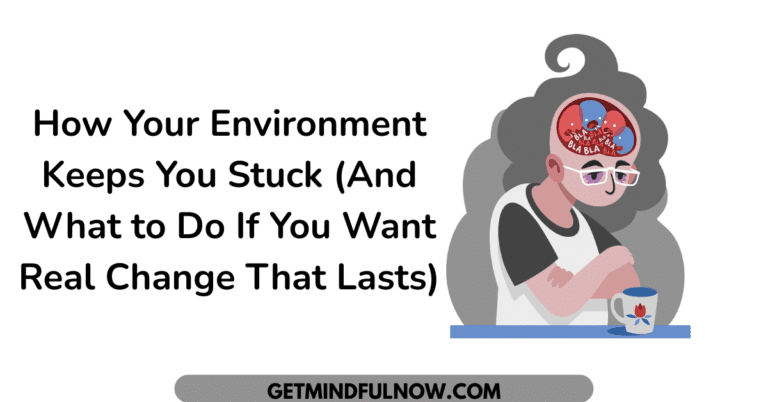You meditate. You journal. You breathe like a monk trying to dodge the Matrix. You tell yourself you’re finally stepping into your higher self.
And then someone cuts you off in traffic. Or your parents drop that same passive-aggressive line they’ve been rehearsing since 1998. Or your boss tries that same tired power move. Suddenly, you’re spiraling. Not because you’re not healed, but because the world around you is still playing an old script.
You didn’t lose your progress.
You just walked into an environment that trained your brain to be that old version of you.
Let’s stop blaming ourselves for the stuckness that has less to do with willpower and more to do with environmental reinforcement.
Because the real truth?
Trying to change without changing your environment is like trying to quit sugar while working at a candy store.
When Your Environment Remembers Who You Used to Be
Your brain becomes a scrapbook of your past, organized by triggers, reactions, and all the ways you’ve been trained to show up. Every place, person, and object that made an emotional impact on you becomes a trigger for your thoughts, feelings, and behaviors.
That’s not spiritual mumbo jumbo, it’s neuroscience.
According to Hebbian theory, when neurons fire together, they wire together. That means if you used to feel small every time you sat at your family’s dinner table, your brain linked that chair, that tone of voice, that smell of chai, with the emotion of feeling invisible.
You don’t even need to think about it anymore. Your environment will trigger that neural program automatically.
So yes, you can do all the inner work. But if you keep surrounding yourself with the same external cues, you’ll keep lighting up the same internal circuits.
You’re not broken. Your environment is just way more persuasive than you realized.
Familiar Triggers Reset Familiar Patterns
You want to be calm. But your environment says, “Time to react.”
You want to feel worthy. But your environment still treats you like an emotional doormat.
This isn’t just frustrating, it’s neurologically exhausting.
Every time you re-enter an environment tied to your past identity, your brain picks up old programs like it’s Spotify resuming a playlist you thought you deleted.
Let’s go deeper into the science:
The basal ganglia (the part of your brain responsible for habit loops) gets activated by cues in your environment. When you walk into a room that holds emotional memory, the trigger cue starts the chain:
Cue → Craving → Response → Reward.
For example:
- Cue: Your mom criticizes your career.
- Craving: You want to feel seen.
- Response: You defend or shut down.
- Reward: Familiar tension, but weirdly comfortable.
Boom. Your neural loop is reinstalled. And this is happening over and over, even when you swear you’re trying to “stay high vibe.”
Until your surroundings support the new you, your brain will keep glitching back to the old one.
The Myth of Inner Work in a Toxic Field
Let’s be honest. Inner work is beautiful, but not bulletproof.
Yes, change begins from the inside. But it won’t last if the world around you keeps nudging you back into the familiar.
You can’t out-journal an environment that constantly gaslights your growth.
Even Dr. Dispenza emphasizes this in one of his book, when we keep experiencing the same people and places, our senses keep firing the same memories. That keeps the past alive in our body, and our brain gets stuck in predicting what already happened, rather than creating something new.
Translation: your environment can literally keep you from stepping into your future self.
And unless you understand this, you’ll keep blaming yourself for not being consistent, when the real issue is:
You’re trying to bloom in soil that remembers your roots too well.
5-Step Daily Meditation to Break Environmental Triggers and Rewire Your Brain
You don’t just escape your environment by physically leaving it, you do it first internally. Every day, you need to sit down, close your eyes, drop into alpha, and rehearse the new script before the world outside tries to hand you the old one.
This isn’t hypothetical. I’ve done this. I’ve sat through mornings where my body wanted to rehearse anxiety, people-pleasing, and hypervigilance the moment I woke up. But I closed my eyes, entered stillness, and made my nervous system memorize something new. You can do it too.
1. Identify the Anchor Triggers (in meditation, not just a journal)
In the first few minutes of meditation, as your brainwaves drop into alpha, scan your mind for who or what makes you shrink. Don’t analyze. Just observe. Let their face, voice, or situation float up. Witness without reacting. This is how you bring the hidden cues out of the shadows.
2. Visualize Interrupting the Pattern
Now, rehearse one situation where that old pattern shows up. Maybe it’s your partner’s criticism, your boss’s passive aggression, or your mom’s guilt trip. Visualize it, but this time, pause. See yourself breathing instead of reacting. Speaking instead of staying silent. Walking away instead of fawning. Do it slowly. Let your body watch you break the script.
3. Mentally Rehearse Your New Identity
Who do you want to be in that same space? Confident, calm, unfazed? Rehearse that. In meditation, your brain doesn’t know the difference between real and imagined. Fire those new circuits. Let them wire.
4. Feel the Emotion of Freedom
thats’s where the nervous system rewiring happens. Don’t just think it, feel it. What would your body feel like if those people or triggers no longer had power over you? Freedom? Lightness? Joy? Embody it. Bathe in it. That emotional signature is your new frequency.
5. Seal It With Intention
End the meditation by affirming your new emotional baseline: “I am no longer defined by my past environment. I belong to my future.” Let that be the final imprint. So when you open your eyes, your external world has to adjust to the internal shift you just created.
If you do this daily, your brain starts preparing for new outcomes. Your autonomic nervous system starts calibrating to safety. And one day, you’ll walk into the same room, and your body won’t flinch. Because it doesn’t live there anymore.
This Isn’t Theory for Me
I once spent 3 months doing deep inner work after a heartbreak. I felt lighter, stronger, clearer. Then I met up with that ex “just to talk like adults.”
Five minutes in, I felt myself shape-shifting. I wasn’t conscious, present, or healed. I was back in people-pleasing mode, trying to avoid discomfort, losing my voice in real-time.
It took me two weeks to recover.
Why?
Because I stepped into an environment that held the blueprint of my past self.
That day, I learned something crucial: healing doesn’t guarantee you’ll stay healed if the setting doesn’t change.
Journal Prompt
Journal:
Where in your life are you trying to change without changing the conditions that trained your old identity?
What would it look like to update your environment to support your future self?
Let your nervous system imprint it.
Final Truth: Your Future Can’t Be Built in a Room That Was Designed for Your Past
If you keep staying in the same environment hoping your inner work will overpower it, you’ll keep falling into the loop of disappointment.
This isn’t your fault.
But it is your responsibility to stop underestimating how much your surroundings shape your identity.
Change the cues, and you change the chemistry.
Change the field, and you change the future.
Want More Like This?
Subscribe to the newsletter for real-deep, zero-fluff guides that decode the neuroscience of transformation, written like we’re in the same room having a no-BS chat about healing, growth, and becoming who you really are.
Or connect with me Threads.
Let’s design a life your old self won’t recognize.








